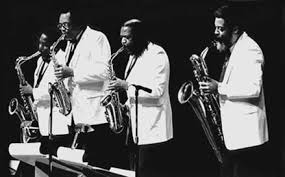 The ‘Front Line’ was a ubiquitous presence in Jazz from the very early stages at the end of the nineteenth century until the beginnings of Bebop in the 1940’s and demise of Big Bands in the 1950’s.
The ‘Front Line’ was a ubiquitous presence in Jazz from the very early stages at the end of the nineteenth century until the beginnings of Bebop in the 1940’s and demise of Big Bands in the 1950’s.
The Front Line is defined as the horns that play in front of the rhythm section. In the earliest stages of Jazz, those horns were the trumpet or coronet, clarinet and, occasionally, a tuba. The sax did not become a regular and accepted part of the line up until the 1930’s.
The rise of Bebop and the demise of the Big Bands changed all that. The earlier players who were developing bop were working in small groups in some of the NYC bars and clubs in the early 1940’s – Mintons is generally perceived of as the cite of the birth of bebop, though it was certainly not the only place players were gathering after hours to experiment.
Big bands were dying for lack of support, both financial and audiences through the forties and early fifties. Elvis and Rock and Roll, were taking over with the public.
Thankfully, Jazz continues – though usually with small groups – trios, quartets, quintets, and, occasionally, somewhat larger groups. Many trios are made up of what was historically the rhythm section: piano, bass, drums. Quartets, quintets and the larger groups usually add a horn or two, though sometimes a guitar.
I should note, however, that there are small groups that are only the Front Line, i.e., horns only. The World Saxophone Quartet is one example.
And, yes, there are still big bands around – the Count Basie Band still tours, as does the Duke Ellington Orchestra. And the Seattle Repertory Jazz Orchestra presents several concerts each year in and around Seattle.
